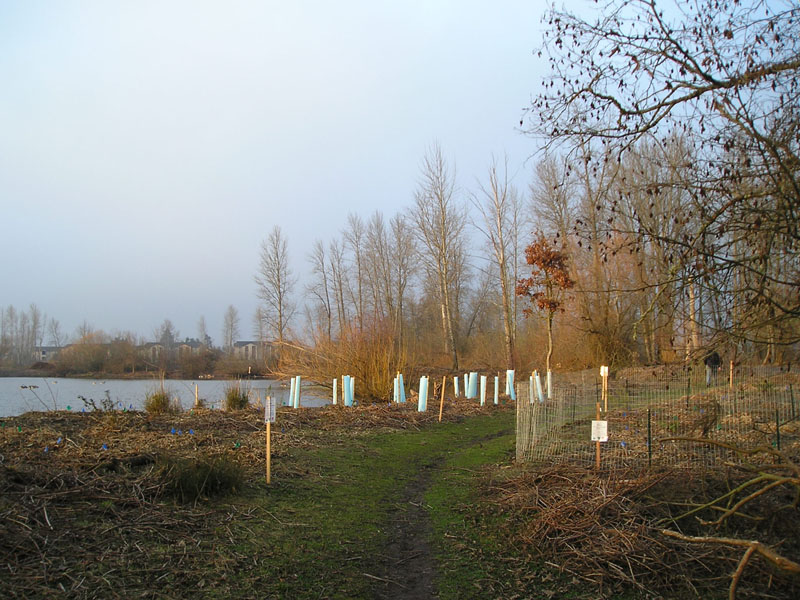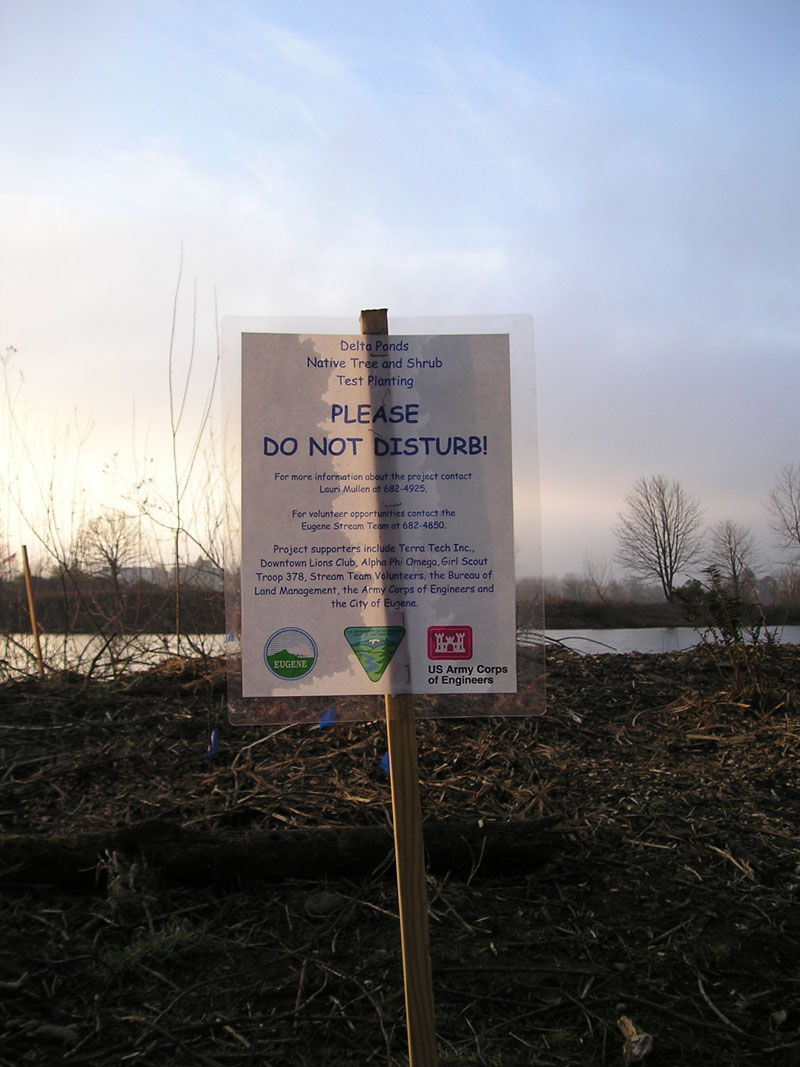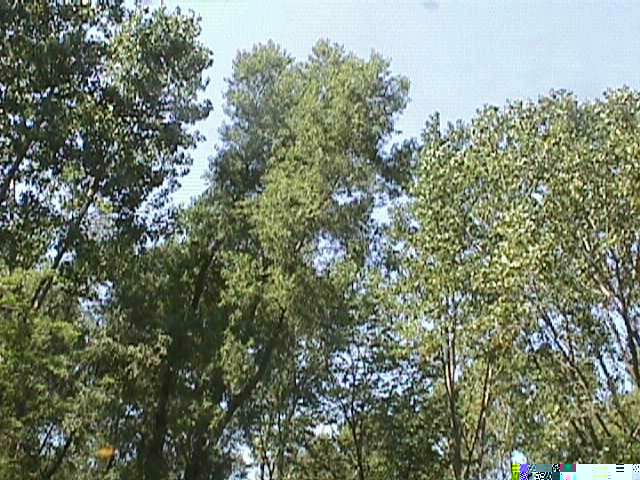Native Tree and Shrub Test Planting

Source: Mona Jones
Test Planting Sign

Source: Mona Jones
Himalayan Blackberry

Source: http://wafa.org.au/articles/weeds/weeds.html
Black Cottonwood Trees

Source: http://www.kusd.edu/img/instrn_images/bong_images/cottonwood.jpg
Vegetation
The history of disturbance to the Delta Ponds ecosystem has created ideal habitat for non-native invasive vegetation, which composes a large percentage of the surveyed area. This initial survey will serve as a baseline from which to measure the progress of successive non-native eradication and native replanting campaigns. Key species are used to describe the dominant vegetation of a small section of the area. There are five key species listed in our vegetation survey.
Black cottonwood (Populus Balsamifera ssp. trichocarpa)
Why is the black cottonwood a key species?
Black cottonwood is native to the Willamette Valley and requires open riparian habitat. . In order to maintain the cool water temperatures that fish and other aquatic species need to reproduce and survive it is important to have a thriving community of tall canopy trees around the Delta ponds.
What does a black cottonwood tree look like?
Black cottonwood trees can reach up to 50 meters in height and are often found clumped together in small groves. At maturity the bark of the black cottonwood at maturity is dark gray and marked with deep vertical grooves. Leaves are 5-15 cm long, alternate, thick, usually shiny and range from oval to heart shaped. Male and female flowers are both catkins but are found on different trees.
What are the threats to black cottonwood trees at Delta Ponds?
Black cottonwood seedlings require partial to full sunlight, which is prohibited by dense thickets of invasive shrubs. Black cottonwoods have short life span therefore without adequate reseeding a black cottonwood forest can thin out rapidly.
What are the monitoring methods used to locate black cottonwoods at Delta Ponds?
Monitoring methods consist of a combination of aerial photo analysis and ground surveys. These methods will yield a map with vegetation zones, squares approximately 30 feet by 30 feet in area, designated by the dominant species of each grid square.
What are the results of the surveys?
This data is not yet compiled but it will eventually be a comprehensive GIS map of the Delta ponds area.
Red and White Alder (Alnus rubra and Alnus rhombifolia)
Why are alders a key species?
They are both native to the Willamette Valley and are important to the Delta Ponds ecosystem for a number of reasons. Once established dense fibrous root systems serve to hold soil together and limit erosion damage in sensitive areas. Furthermore the root systems of alders provide habitat for the nitrogen fixing bacteria actinomycetes. By changing the soil chemistry alders create habitat that is well suited for native species of grass, sedge, and ferns.
What do alder trees look like?
Mature alders grow to heights of 25-35 meters often several trees grow out of one root location. Their bark is thin, gray and generally smooth although it often appears scaly due to extensive lichen colonies. Leaves are 5-10 cm long, oblong-ovate shaped with wavy margins that come to a sharp terminal tip. The red alder can be distinguished from the white alder by its leaves. The red alder has leaves that roll under along the margins. Both trees have female and male catkins on the same tree. The female catkin is only 1-2 cm long and turns woody at maturity. Male catkins are 5-10cm long, reddish-yellow and appear before the leaves.
What are the threats to alders in the Delta Ponds area?
Alder seedlings are threatened by invasive species similarly to black cottonwood seedlings. They too require at least partial sunlight to grow and are short lived as mature trees.
What are the monitoring methods used to locate alders at Delta Ponds?
Monitoring methods consist of a combination of aerial photo analysis and ground surveys. These methods will yield a map with vegetation zones, squares approximately 30 feet by 30 feet in area, designated by the dominant species of each grid square.
What are the results of the surveys?
This data is not yet compiled but it will eventually be a comprehensive GIS map of the Delta ponds area.
Big Leaf Maple ( Acer macrophyllum)
Why are big leaf maples a key species?
The big leaf maple is native to the Willamette Valley and provides both food and cover for a variety of mammals. Persistent samaras and numerous seedlings provide food for birds and burrowing. Wide horizontal branches provide excellent habitat for epiphytic vegetation. The wide leaf canopy also provides shade for aquatic ecosystems.
What does a big leaf maple look like?
The big leaf maple grows up to 35 meters in height. The young bark is smooth and green while the older bark is grayish, ridged and usually covered with moss and epiphytic ferns. Leaves are 5-30 cm in width, opposite, and five lobed in the characteristic shape of maple leaves. Flowers are 3 mm across and green, they occur in long hanging clusters. Maple fruit are double winged samaras that range from 3-6 cm and are semi-persistent in the winter.
What are the threats to big leaf maples at the Delta Ponds?
Maple seedlings are threatened by invasive species similarly to black cottonwood and alder seedlings. They too require at least partial sunlight to grow and are short lived as mature trees.
What are the monitoring methods used to locate big leaf maples at Delta Ponds?
Monitoring methods consist of a combination of aerial photo analysis and ground surveys. These methods will yield a map with vegetation zones, squares approximately 30 feet by 30 feet in area, designated by the dominant species of each grid square.
What are the results of the surveys?
This data is not yet compiled but it will eventually be a comprehensive GIS map of the Delta ponds area.
Willow ( Salix spp.)
Why are willows a key species?
Willows can live in rocky alluvial soil and often serve to stabilize river and steam banks during floods. They also provide food and habitat for many species of animals.
What does a willow look like?
Willows range from 50 cm to 12 m in height and have small, erect and spreading branches. Willows are deciduous and have alternating leaves that range from 4-15 cm and from elliptical to linear. Leaf margins often appear smooth but can be finely toothed. Male and female flowers appear in catkins. Female catkins are generally larger and can range from 6-12 cm while the male catkins range from 2-7 cm in length. Depending on the subspecies male and female catkins may appear on different plants.
What are the threats to willows at Delta Ponds?
Willows are hardy and more aggressive as seedlings than the previously listed species, however they are in competition with blackberries for some sunlight.
What are the monitoring methods used to locate willows at Delta Ponds?
Monitoring methods consist of a combination of aerial photo analysis and ground surveys. These methods will yield a map with vegetation zones, squares approximately 30 feet by 30 feet in area, designated by the dominant species of each grid square.
What are the results of the surveys?
This data is not yet compiled but it will eventually be a comprehensive GIS map of the Delta ponds area.
Himalayan blackberry (Rubus discolor)
Why is Himalayan blackberry a key species?
Himalayan blackberry is an aggressive invasive that thrives in disturbed soil. Its extremely dense growth habits compete fiercely with native shrubs and other flora often choking out less aggressive species. The history of disturbance at the Delta Ponds created ideal habitat for this invasive and it has been targeted for aggressive removal.
What does Himalayan blackberry look like?
Himalayan blackberries are vines with thick sharp spines that grow up to 3 meters in height. Vines are sprawling and recurve to the ground where they grow for up to 10 meters in length. Blackberry vines are biennial producing flowers and fruit on lateral shoots during the second year. Leaves are ovate with serrate margins and are trifoliate on the flowering branches while 5-foliate on vegetative shoots. Blackberry flowers are 2-3 cm and occur in clusters. The flowers are perfect, five-petaled and range from white to rose colored. Edible black aggregate fruit appear in early to late September.
What are the monitoring method used to look for Himalayan blackberries?
Monitoring methods consist of a combination of aerial photo analysis and ground surveys. These methods will yield a map with vegetation zones, squares approximately 30 feet by 30 feet in area, designated by the dominant species of each grid square.
What are the results of the surveys?
This data is not yet compiled but it will eventually be a comprehensive GIS map of the Delta ponds area.
For more information about the vegetation at Delta Ponds see:
